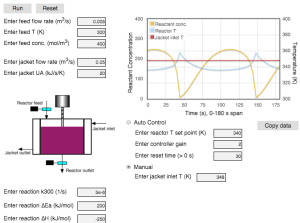The Reactor Lab desktop app is built with LiveCode, a cross-platform rapid application development tool. In the Resources, Web app experiments section of this site, we are experimenting with HTML5 technologies – Javascript and CSS – to make interactive web apps. Here are some initial impressions.
HTML5 web apps have the advantage of cross-platform deployment – of a single set of files – on all platforms (operating systems) via web browsers. Web apps don’t have all the functionality of desktop apps and smart phone apps but they do have the main functionality we are looking for. LiveCode has cross-platform deployment on the desktop and as smart phone apps but you have to build and deploy a separate distribution for each platform. Web deployment is under development in LiveCode version 8 but our initial experiments show that loading the first app is slow: about 40 s currently in my browser in California fetching the page from the server in France, where load times increase with distance from the server. But this is a development version of LC 8 and speeds may improve in the future. In contrast, HTML5 web apps are small and load fast.
Layout of LiveCode screens (“cards”) is easy and fast. Just drag and drop both active (e.g., buttons and widgets) and graphical elements. You can easily change the appearance and locations of elements with script when the app is running – so far it seems more easily than in HTML5. For HTML5 apps, we are using the desktop tool MACAW. In that tool, you can also drag and drop elements onto a page, then generate HTML and CSS files but not nearly as easily as LiveCode.
LiveCode is programmed with a very high level, English-like language that is easy to learn. Code (scripts) can be embedded in objects on the screen (e.g., buttons) or placed at a top level (card, stack). Proprietary code can be encrypted in the paid version. HTML5 web apps are programmed with Javascript. We have found Javascript easy to learn, although we have been programming for 50 years in a dozen languages, so we can’t say how easy it will be for a novice. The site w3schools.com is a great resource for learning Javascript, as well as HTML and CSS. Javascript is not attached to individual screen elements but placed at a top level, either in a script tag in the HTML file or, better, in a separate JS file. We haven’t tried text handling in Javascript but text handling in LiveCode is super easy.
Bottom line of initial impressions? LiveCode wins in ease of development and power. HTML5 wins in deployment – one set of files across all platforms – and speed of loading. We are leaning to devoting our efforts for future development to HTML5, although we are going to keep an eye on LiveCode to see if the speed of loading web apps improves significantly.
